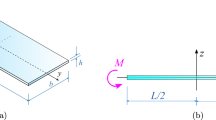Abstract
Laminated structures are parallel (or redundant) systems, i.e. failure occurs when all the elements (glass plies) reach, in cascade, the ultimate limit state. Following the failure mode approach, the reliability analysis is consequent to the identification of all possible rupture modes of the glass plies, where each mode is identified by the sequence of collapse, synthetically schematized as an event-tree. The event “structural failure” is the union of all the possible failure modes. The static theorem of limit analysis guarantees that the more the structure is divided into load bearing elements acting in parallel, the safer it is, but this conclusion holds only for ideal ductile systems. For brittle glass it is often assumed that lamination gives a beneficial contribution in all cases, but glass strength is affected by a size effect in terms of area, because surface micro-cracks govern the overall capacity of the material. Taking this into account, we show through the failure mode approach, under some simplifying assumptions, that lamination can decrease the strength of a plate made of annealed glass, since the higher the number of plies is, the larger is the surface area under tensile stress. This finding focalizes the attention on the importance of an accurate characterization of the size effect in glass strength.









Similar content being viewed by others
References
Augusti, G., Baratta, A.: Limit analysis of structures with stochastic strength variations. J. Struct. Mech. 1(1), 43–62 (1972)
Ballarini, R., Pisano, G., Royer Carfagni, G.: The lower bound for glass strength and its interpretation with generalized Weibull statistics for structural applications. ASCE J. Eng. Mech. 142(12), 04016100 (2016)
Baraldi, D., Cecchi, A., Foraboschi, P.: Broken tempered laminated glass: Non-linear discrete element modeling. Compos. Struct. 140, 278–295 (2016)
Behr, R., Minor, J., Norville, H.: Structural behavior of architectural laminated glass. J. Struct. Eng. 119, 202–222 (1993)
Bennison, S., Jagota, A., Smith, C.: Fracture of glass/poly(vinyl butyral) (butacite) laminates in biaxial flexure. J. Am. Ceram. Soc. 82(7), 1761–1770 (1999)
Biolzi, L., Orlando, M., Piscitelli, L.R., Spinelli, P.: Static and dynamic response of progressively damaged ionoplast laminated glass beams. Compos. Struct. 157, 337–347 (2016)
Bonati, A., Pisano, G., Royer Carfagni, G.: Redundancy and robustness of brittle laminated plates: overlooked aspects in structural glass. Compos. Struct. 227, 111288 (2019)
Calderone, I., Davies, P., Bennison, S., Huang, X., Gang, L.: Effective laminate thickness for the design of laminated glass. In: Proceedings of Glass Performance Days, Tampere, FI (2009)
CEN/TC129/WG8: An overview of prEN-13474 and the work of CEN/TC129/WG8 from which it was developed. Internal Document (2006)
CNR-DT 210: National Research Council of Italy. Guide for the Design, Construction and Control of Buildings with Structural Glass Elements. Technical Recommendations for Construction (2013)
Evans, A.G.: A general approach for the statistical anlysis of multiaxial fracture. J. Am. Ceram. Soc. 61, 302–308 (1978)
Galuppi, L., Royer Carfagni, G.: Enhanced effective thickness of multi-layered laminated glass. Compos. Part B Eng. 64, 202–2013 (2014)
Irwin, G.: Analysis of stresses and strains near the end of a crack traversing a plate. J. Appl. Mech. 24, 361–364 (1957)
Melchers, R.E., Beck, A.T.: Structural Reliability Analysis and Prediction, 3rd edn. Wiley, London (2018)
Munz, D., Fett, T.: Ceramics: Mechanical Properties, Failure Behavior, Materials Selection. Springer, Heidelberg (1999)
Pisano, G., Royer Carfagni, G.: The statistical interpretation of the strength of float glass for structural applications. Constr. Build. Mater. 98, 741–756 (2015)
Pisano, G., Royer Carfagni, G.: Towards a new standardized configuration for the coaxial double test for float glass. Eng. Struct. 119, 149–163 (2016)
Pisano, G., Royer Carfagni, G.: A micromechanical derivation of the macroscopic strength statistics for pristine or corroded/abraded float glass. J. Eur. Cerem. Soc. 37, 4197–4206 (2017)
Seshadri, M., Bennison, S., Jagota, A., Saigal, S.: Mechanical response of cracked laminated plates. Acta Mater. 50, 4477–4490 (2002)
Simiu, E., Reed, A.D., Yancey, C.W.C., Martin, J.W., Hendrikson, E.M., Gonzalez, A.C. et al.: Ring-on-ring test and load capacity of cladding glass. Technical Report NBS Building Science Series 162, National Bureau of Standards, U.S. Department of Commerce (1984)
Vandebroek, M., Louter, C., Caspeele, R., Ensslen, F., Belis, J.: Size effect model for the edge strength of glass and ground edge finishing. Eng. Struct. 79, 96–105 (2014)
Weibull, W.: A statistical theory of the strength of materials. Ingenirsvetenskapsakademiens Handlingar 151, 1–45 (1939)
Wiederhorn, S.M., Bolz, L.H.: Stress corrosion and static fatigue of glass. J. Am. Ceram. Soc. 53(10), 543–548 (1970)
Wiederhorn, S.M.: Strength of glass: a fracture mechanics approach. Technical Report AD-780 704, National Bureau of Standards, Office Naval Research (1974)
Acknowledgements
GRC acknowledges the support of the Italian Dipartimento della Protezione Civile under project ReLUIS-DPC 2019-2021 and the support of the Italian Ministero dell’Istruzione, dell’Università e della Ricerca under grant MIUR-PRIN voce COAN 5.50.16.01 code 2015JW9NJT.
Author information
Authors and Affiliations
Corresponding author
Additional information
Publisher's Note
Springer Nature remains neutral with regard to jurisdictional claims in published maps and institutional affiliations.
Rights and permissions
About this article
Cite this article
Bonati, A., Pisano, G. & Royer Carfagni, G. Probabilistic considerations about the strength of laminated annealed float glass. Glass Struct Eng 5, 27–40 (2020). https://doi.org/10.1007/s40940-019-00111-8
Received:
Accepted:
Published:
Issue Date:
DOI: https://doi.org/10.1007/s40940-019-00111-8




